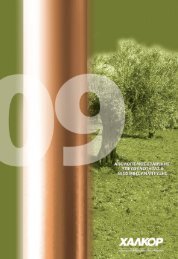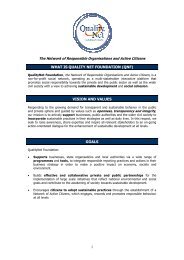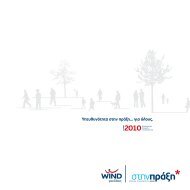APOLOGISMOS CCHBC final - Coca-Cola Hellenic
APOLOGISMOS CCHBC final - Coca-Cola Hellenic
APOLOGISMOS CCHBC final - Coca-Cola Hellenic
You also want an ePaper? Increase the reach of your titles
YUMPU automatically turns print PDFs into web optimized ePapers that Google loves.
nvironment environment environment environment environment environment environment environment environment environment environment environment environment environment environment environment environm<br />
Water<br />
As a prime user of water for our core products,<br />
we are keenly aware of the ecological impacts of<br />
beverage production on water resources and are<br />
improving our management of them.<br />
Water consumption<br />
The <strong>Coca</strong>-<strong>Cola</strong> system takes stringent measures<br />
to ensure that water it is treated and purified to<br />
the highest standards prior to use. Measures<br />
involve multi-barrier filtration and other methods,<br />
to ensure that we achieve the appropriate level of<br />
water purity.<br />
Water is also used in cleaning processes, for rinsing,<br />
washing, cooling and disinfecting beverage<br />
containers and manufacturing installations.<br />
WATER IMPROVEMENTS<br />
PROGRAMMES<br />
Water recovery projects have led to durable water<br />
savings in many plants. For example, clean cooling<br />
water from pasteurizers or rinsing water has been<br />
recuperated and re-used. Despite increasingly complex<br />
product mixes and stricter cleaning standards<br />
requiring more water, water use has remained stable<br />
across our operations (see graph).<br />
3.5<br />
3.0<br />
2.5<br />
Water use in L/lpb<br />
product water<br />
45%<br />
rinse water at water<br />
purification<br />
16% CIP 2%<br />
LOOKING AHEAD<br />
bottle washer<br />
9%<br />
rinsing of packages 5%<br />
conveyor lubrication 1%<br />
cooling water 2%<br />
general cleaning<br />
and others<br />
16%<br />
boiler feed water 2%<br />
sanitary 2%<br />
Graph (pie chart): Typical water uses in <strong>Coca</strong>-<strong>Cola</strong> HBC<br />
plants (example Plant Dietlikon, Switzerland)<br />
EMISSIONS AND EFFLUENTS<br />
Emissions<br />
There are no significant specific emissions of substances<br />
from <strong>Coca</strong>-<strong>Cola</strong> HBC operations, such as<br />
volatile organic compounds. The emissions from<br />
beverage production activities result from the<br />
combustion of fossil fuels such as heating oil, natural<br />
gas, petrol and diesel, similar to those from<br />
household heating and vehicle use. The quality of<br />
the fuel, in particular its sulphur content, has a<br />
large influence on the resulting emissions. The<br />
consumption of electricity indirectly produces air<br />
emissions, not where the electricity is used but<br />
where it is produced. The resulting calculated<br />
emissions are included in the reported emissions<br />
using the euro-mix definition.<br />
The ratio of total water consumed to volume of<br />
produced beverage is defined as a water ratio and<br />
represents one of the main environmental Key<br />
Performance Indicators. The average ratio for<br />
<strong>Coca</strong>-<strong>Cola</strong> HBC operations in 2003 was 3.3 litres<br />
per litre of finished product.<br />
In 2003 the company’s plants used 20 million<br />
cubic meters of water. The country averages are<br />
shown in the benchmarking section.<br />
<strong>Coca</strong>-<strong>Cola</strong> HBC is actively engaged in efforts to<br />
conserve and protect water used in its own facilities<br />
and in each of the communities it serves.<br />
It is a goal of the <strong>Coca</strong>-<strong>Cola</strong> system to eventually<br />
make every production unit a “green plant”, with<br />
zero liquid discharge.<br />
Waste Water<br />
2.0<br />
1.5<br />
1.0<br />
0.5<br />
0.0<br />
2000 2001 2002 2003<br />
goal<br />
2004<br />
Graph (columns): Average water ratio <strong>Coca</strong>-<strong>Cola</strong> HBC (l/lpb)<br />
vs. year 2000, 2001, 2002, 2003, goal 2004<br />
Operations in Croatia are achieving significant<br />
progress toward this goal on a continuing basis,<br />
with the redesign of wastewater treatment equipment<br />
and drainage systems that exceed regulatory<br />
requirements. The effort has been cited as an ecoefficiency<br />
case study by the World Business<br />
Council for Sustainable Development.<br />
The Croatian efforts have to date succeeded in<br />
reducing wastewater, recycling cleansed water for<br />
re-use, elevating water quality levels and enabling<br />
distribution of by-products for farming.<br />
In Poland, in 2003, a comprehensive programme<br />
was begun that is reducing water use by as much<br />
as 17% so far, through recycling and effective<br />
water management methods, and cutting discharge<br />
levels.<br />
Because water is a key resource in the production<br />
of beverages, <strong>Coca</strong>-<strong>Cola</strong> HBC makes it a high priority<br />
to protect water sources and aquatic ecosystems.<br />
Most operations have projects for 2004 for<br />
reducing water use, recovering water, or improving<br />
wastewater quality. The company’s objective<br />
for 2004 is to reduce the average water ratio by<br />
5% vs. 2003 (see graph).<br />
As market leaders within the beverage segment,<br />
<strong>Coca</strong>-<strong>Cola</strong> HBC is focussed on increasing water<br />
savings, conservation and protection activities. In<br />
collaboration with local authorities and NGOs,<br />
<strong>Coca</strong>-<strong>Cola</strong> HBC strives to protect the biodiversity in<br />
living ecosystems, in particular forests, grassland,<br />
wetlands and all bodies of water that are essential<br />
for water supply. Much remains to be done, but<br />
we strongly believe that the programmes put in<br />
place will yield long-term results and benefit the<br />
communities we serve.<br />
Burning fossil fuels produces various air emissions.<br />
Among them, carbon dioxide (CO2) that<br />
contributes to global warming; nitrous oxides<br />
(NOx) that may lead to summer smog and water<br />
eutrophication (over-fertilisation of lakes); sulphur<br />
oxide (SO2) that results in acid rain; and particulates<br />
(PM10) that have a negative effect on<br />
breathing. The calculated air emissions resulting<br />
from energy consumption are reported in the<br />
Environmental data table.<br />
Wastewater<br />
The main substances emitted with wastewater in<br />
the production process are residues of cleaning<br />
and disinfecting substances, and to a lesser extent<br />
beverage residues and sanitary wastewater. Most<br />
of these substances can be biodegraded if treated<br />
properly.<br />
<strong>Coca</strong>-<strong>Cola</strong> HBC ensures that its wastewater is<br />
treated before reaching natural bodies of water.<br />
The methods of treatment differ among plants and<br />
among countries. Approximately 90% of European<br />
operations have on-site neutralisation of production<br />
water, 60% have an on-site wastewater treatment<br />
system, and 20% are connected to a public<br />
wastewater treatment plant.<br />
Production plants with their own wastewater treatment<br />
plants typically have a fish tank or pond<br />
which serves to test the effluent. The live fish are<br />
indicators of an acceptable water quality.<br />
32<br />
33







